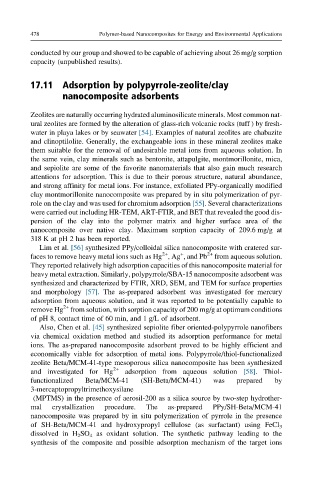Page 525 - Polymer-based Nanocomposites for Energy and Environmental Applications
P. 525
478 Polymer-based Nanocomposites for Energy and Environmental Applications
conducted by our group and showed to be capable of achieving about 26 mg/g sorption
capacity (unpublished results).
17.11 Adsorption by polypyrrole-zeolite/clay
nanocomposite adsorbents
Zeolites are naturally occurring hydrated aluminosilicate minerals. Most common nat-
ural zeolites are formed by the alteration of glass-rich volcanic rocks (tuff ) by fresh-
water in playa lakes or by seawater [54]. Examples of natural zeolites are chabazite
and clinoptilolite. Generally, the exchangeable ions in these mineral zeolites make
them suitable for the removal of undesirable metal ions from aqueous solution. In
the same vein, clay minerals such as bentonite, attapulgite, montmorillonite, mica,
and sepiolite are some of the favorite nanomaterials that also gain much research
attentions for adsorption. This is due to their porous structure, natural abundance,
and strong affinity for metal ions. For instance, exfoliated PPy-organically modified
clay montmorillonite nanocomposite was prepared by in situ polymerization of pyr-
role on the clay and was used for chromium adsorption [55]. Several characterizations
were carried out including HR-TEM, ART-FTIR, and BET that revealed the good dis-
persion of the clay into the polymer matrix and higher surface area of the
nanocomposite over native clay. Maximum sorption capacity of 209.6 mg/g at
318 K at pH 2 has been reported.
Lim et al. [56] synthesized PPy/colloidal silica nanocomposite with cratered sur-
+
2+
faces to remove heavy metal ions such as Hg ,Ag , and Pb 2+ from aqueous solution.
They reported relatively high adsorption capacities of this nanocomposite material for
heavy metal extraction. Similarly, polypyrrole/SBA-15 nanocomposite adsorbent was
synthesized and characterized by FTIR, XRD, SEM, and TEM for surface properties
and morphology [57]. The as-prepared adsorbent was investigated for mercury
adsorption from aqueous solution, and it was reported to be potentially capable to
2+
remove Hg from solution, with sorption capacity of 200 mg/g at optimum conditions
of pH 8, contact time of 60 min, and 1 g/L of adsorbent.
Also, Chen et al. [45] synthesized sepiolite fiber oriented-polypyrrole nanofibers
via chemical oxidation method and studied its adsorption performance for metal
ions. The as-prepared nanocomposite adsorbent proved to be highly efficient and
economically viable for adsorption of metal ions. Polypyrrole/thiol-functionalized
zeolite Beta/MCM-41-type mesoporous silica nanocomposite has been synthesized
and investigated for Hg 2+ adsorption from aqueous solution [58]. Thiol-
functionalized Beta/MCM-41 (SH-Beta/MCM-41) was prepared by
3-mercaptopropyltrimethoxysilane
(MPTMS) in the presence of aerosil-200 as a silica source by two-step hydrother-
mal crystallization procedure. The as-prepared PPy/SH-Beta/MCM-41
nanocomposite was prepared by in situ polymerization of pyrrole in the presence
of SH-Beta/MCM-41 and hydroxypropyl cellulose (as surfactant) using FeCl 3
dissolved in H 2 SO 4 as oxidant solution. The synthetic pathway leading to the
synthesis of the composite and possible adsorption mechanism of the target ions

